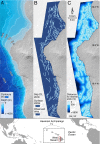Prey-size plastics are invading larval fish nurseries
- PMID: 31712423
- PMCID: PMC6883795
- DOI: 10.1073/pnas.1907496116
Prey-size plastics are invading larval fish nurseries
Abstract
Life for many of the world's marine fish begins at the ocean surface. Ocean conditions dictate food availability and govern survivorship, yet little is known about the habitat preferences of larval fish during this highly vulnerable life-history stage. Here we show that surface slicks, a ubiquitous coastal ocean convergence feature, are important nurseries for larval fish from many ocean habitats at ecosystem scales. Slicks had higher densities of marine phytoplankton (1.7-fold), zooplankton (larval fish prey; 3.7-fold), and larval fish (8.1-fold) than nearby ambient waters across our study region in Hawai'i. Slicks contained larger, more well-developed individuals with competent swimming abilities compared to ambient waters, suggesting a physiological benefit to increased prey resources. Slicks also disproportionately accumulated prey-size plastics, resulting in a 60-fold higher ratio of plastics to larval fish prey than nearby waters. Dissections of hundreds of larval fish found that 8.6% of individuals in slicks had ingested plastics, a 2.3-fold higher occurrence than larval fish from ambient waters. Plastics were found in 7 of 8 families dissected, including swordfish (Xiphiidae), a commercially targeted species, and flying fish (Exocoetidae), a principal prey item for tuna and seabirds. Scaling up across an ∼1,000 km2 coastal ecosystem in Hawai'i revealed slicks occupied only 8.3% of ocean surface habitat but contained 42.3% of all neustonic larval fish and 91.8% of all floating plastics. The ingestion of plastics by larval fish could reduce survivorship, compounding threats to fisheries productivity posed by overfishing, climate change, and habitat loss.
Keywords: larval fish; microplastics; nursery habitat; surface slicks.
Copyright © 2019 the Author(s). Published by PNAS.
Conflict of interest statement
The authors declare no competing interest.
Figures



Comment in
-
Marine Life Cycle: A Polluted Terra Incognita Is Unveiled.Curr Biol. 2020 Feb 3;30(3):R130-R133. doi: 10.1016/j.cub.2019.11.083. Curr Biol. 2020. PMID: 32017885
References
-
- Leis J. M., McCormick M. I., “The biology, behavior, and ecology of the pelagic, larval stage of coral reef fishes”, in Coral Reef Fishes: Dynamics and Diversity in a Complex Ecosystem, Sale P. F., Ed. (Academic Press, San Diego, CA, 2002), pp. 171–199.
-
- Letcher B. H., Rice J. A., Crowder L. B., Rose K. A., Variability in survival of larval fish: Disentangling components with a generalized individual-based model. Can. J. Fish. Aquat. Sci. 53, 787–801 (1996).
-
- Kingsford M., Choat J., Influence of surface slicks on the distribution and onshore movements of small fish. Mar. Biol. 91, 161–171 (1986).
-
- Woodson C. B., The fate and impact of internal waves in nearshore ecosystems. Annu. Rev. Mar. Sci. 10, 421–441 (2018). - PubMed
-
- Ermakov S. A., Pelinovsky E. N., Variation of the spectrum of wind ripple on coastal waters under the action of internal waves. Dyn. Atmos. Oceans 8, 95–100 (1984).
Publication types
MeSH terms
Substances
LinkOut - more resources
Full Text Sources

